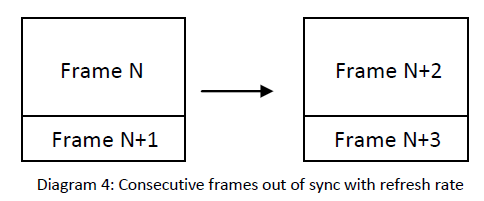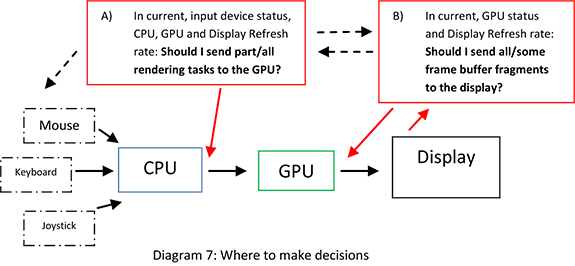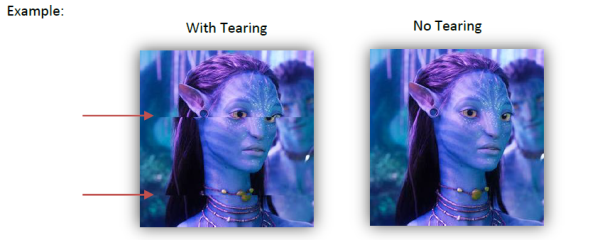Intel Z77 Panther Point Chipset and Motherboard Preview – ASRock, ASUS, Gigabyte, MSI, ECS and Biostar
by Ian Cutress on April 8, 2012 12:00 AM EST- Posted in
- Motherboards
- Intel
- Biostar
- MSI
- Gigabyte
- ASRock
- Asus
- Ivy Bridge
- ECS
- Z77
LucidLogix Virtu MVP Technology and HyperFormance
While not specifically a feature of the chipset, Z77 will be one of the first chipsets to use this remarkable new technology. LucidLogix was the brains behind the Hydra chip—a hardware/software combination solution to allow GPUs from different manufacturers to work together (as we reviewed the last iteration on the ECS P62H2-A). Lucid was also behind the original Virtu software, designed to allow a discrete GPU to remain idle until needed, and let the integrated GPU deal with the video output (as we reviewed with the ASUS P8Z68-V Pro). This time, we get to see Virtu MVP, a new technology designed to increase gaming performance.
To explain how Virtu MVP works, I am going to liberally utilize and condense what is said in the Lucid whitepaper about Lucid MVP, however everyone is free to read what is a rather interesting ten pages.
The basic concept behind Virtu MVP is the relationship between how many frames per second the discrete GPU can calculate, against what is shown on the screen to the user, in an effort to increase the 'immersive experience'.
Each screen/monitor the user has comes with a refresh rate, typically 60 Hz, 75 Hz or 120 Hz with 3D monitors (Hz = Hertz, or times ‘per second’). This means that at 60 times per second, the system will pull out what is in the frame buffer (the bit of the output that holds what the GPU has computed) and display what is on the screen.
With standard V-Sync, the system will only pull out what is in the buffer at certain intervals—namely at factors of the base frequency (e.g. 60, 30, 20, 15, 12, 10, 6, 5, 3, 2, or 1 for 60Hz) depending on the monitor being used. The issue is with what happens when the GPU is much faster (or slower) than the refresh rate.
The key tenet of Lucid’s new technology is the term responsiveness. Responsiveness is a wide-ranging term which could mean many things. Lucid distils it into two key areas:
a) How many frames per second can the human eye see?
b) How many frames per second can the human hand respond to?
To clarify, these are NOT the same questions as:
i) How many frames per second do I need to make the motion look fluid?
ii) How many frames per second makes a movie stop flickering?
iii) What is the fastest frame (shortest time) a human eye would notice
If the display refreshes at 60 Hz, and the game runs at 50 fps, would this need to be synchronized? Would a divisor of 60 Hz be better? Alternatively, perhaps if you were at 100 fps, woud 60 fps be better? The other part of responsiveness is how a person deals with hand-to-eye coordination, and if the human mind can correctly interpolate between a screen's refresh rate and the output of the GPU. While a ~25 Hz rate may be applicable for a human eye, the human hand can be as sensitive as 1000 Hz, and so having the correlation between hand movement and the eye is all-important for 'immersive' gaming.
Take the following scenarios:
Scenario 1: GPU is faster than Refresh Rate, VSync Off
Refresh rate: 60 Hz
GPU: 87 fps
Mouse/Keyboard responsiveness is 1-2 frames, or ~11.5 to 23 milliseconds
Effective responsiveness makes the game feel like it is between 42 and 85 FPS
In this case, the GPU is 45% faster than the screen. This means that as the GPU fills the frame buffer, it will continuously be between frames when the display dumps the buffer contents on screen, such that the computation of the old frame and the new frame is still in the buffer:

This is a phenomenon known as Tearing (which many of you are likely familiar with). Depending on the scenario you are in, tearing may be something you ignore, notice occasionally, or find rather annoying. For example:
So the question becomes, was it worth computing that small amount of frame N+1 or N+3?
Scenario 2: GPU is slower than Refresh Rate, VSync Off
Refresh rate: 60 Hz
GPU: 47 fps
Mouse/Keyboard responsiveness is 1-2 frames, or ~21.3 to 43 milliseconds
Effective responsiveness makes the game feel it is between 25 and 47 FPS
In this case, the GPU is ~37% slower than the screen. This means that as the GPU fills the frame buffer slower than what the screen requests and it will continuously be between frames when the display dumps the buffer contents on screen, such that the computation of the old frame and the new frame is still in the buffer.
 So does this mean that for a better experience, computing frame N+1 was not needed, and N+2 should have been the focus of computation?
So does this mean that for a better experience, computing frame N+1 was not needed, and N+2 should have been the focus of computation?
Scenario 3: GPU can handle the refresh rate, V -Sync On
This setting allows the GPU to synchronize to every frame. Now all elements of the system are synchronized to 60 Hz—CPU, application, GPU and display will aim for 60 Hz, but also at lower intervals (30, 20, etc.) as required.
While this produces the best visual experience with clean images, the input devices for haptic feedback are limited to the V-Sync rate. So while the GPU could enable more performance, this artificial setting is capping all input and output.
Result:
If the GPU is slower than the display or faster than the display, there is no guarantee that the frame buffer that is drawn on the display is of a complete frame. A GPU has multiple frames in its pipeline, but only few are ever displayed at high speeds, or frames are in-between when the GPU is slow. When the system is set a software limit, responsiveness decreases. Is there a way to take advantage of the increased power of systems while working with a limited refresh rate—is there a way to ignore these redundant tasks to provide a more 'immersive' experience?
LucidLogix apparently has the answer…
The answer from Lucid is Virtu MVP. Back in September 2011, Ryan gave his analysis on the principles of the solution. We are still restricted to the high level overview (due to patents) explanation as Ryan was back then. Nevertheless, it all boils down to the following image:

Situation (A) determines whether a rendering task/frame should be processed by the GPU, and situation (B) decides which frames should go to the display. (B) helps with tearing, while (A) better utilizes the GPU. Nevertheless, the GPU is doing multiple tasks—snooping to determine which frames are required, rendering the desired frame, and outputting to a display. Lucid is using hybrid systems (those with an integrated GPU and a discrete GPU) to overcome this.
Situation (B) is what Lucid calls its Virtual V-Sync, an adaptive V-Sync technology currently in Virtu. Situation (A) is an extension of this, called HyperFormance, designed to reduce input lag by only sending required work to the GPU rather than redundant tasks.
Within the hybrid system, the integrated GPU takes over two of the tasks for the GPU—snooping for required frames, and display output. This requires a system to run in i-Mode, where the display is connected to the integrated GPU. Users of Virtu on Z68 may remember this: back then it caused a 10% decrease in output FPS. This generation of drivers and tools should alleviate some of this decrease.
What this means for Joe Public
Lucid’s goal is to improve the 'immersive experience' by removing redundant rendering tasks, making the GPU synchronize with the refresh rate of the connected display and reduce input lag.
By introducing a level of middleware that intercepts rendering calls, Virtual V-Sync and HyperFormance are both tools that decide whether a frame should be rendered and then delivered to the display. However the FPS counter within a title counts frame calls, not completed frames. So as the software intercepts a call, the frame rate counter is increased, whether the frame is rendered or not. This could lead to many unrendered frames, and an artificially high FPS number, when in reality the software is merely optimizing the sequence of rendering tasks rather than increasing FPS.
If it helps the 'immersion factor' of a game (less tearing, more responsiveness), then it could be highly beneficial to gamers. Currently, to work as Lucid has intended, they have validated around 100 titles. We spoke to Lucid (see next page), and they say that the technology should work with most, if not all titles. Users will have to add programs manually to take advantage of the technology if the software is not in the list. The reason for only 100 titles being validated is that each game has to be validated with a lot of settings, on lots of different kit, making the validation matrix huge (for example, 100 games x 12 different settings x 48 different system hardware configurations = time and lots of it).
Virtu MVP causes many issues when it comes to benchmarking and comparison of systems as well. The method of telling the performance of systems apart has typically been the FPS values. With this new technology, the FPS value is almost meaningless as it counts the frames that are not rendered. This has consequences for benchmarking companies like Futuremark and overclockers who like to compare systems (Futuremark have released a statement about this). Technically all you would need to do (if we understand the software correctly) to increase your score/FPS would be to reduce the refresh rate of your monitor.
Since this article was started, we have had an opportunity to speak to Lucid regarding these technologies, and they have pointed out several usage scenarios that have perhaps been neglected in other earlier reviews regarding this technology. In the next page, we will discuss what Lucid considers ‘normal’ usage.












145 Comments
View All Comments
mechjman - Monday, April 9, 2012 - link
I don't remember seeing PCIe 3.0 support straight from P6x series chipsets.http://www.intel.com/content/www/us/en/chipsets/ma...
If this is regarding in use with a PLX chip, it might be good to state so.
extide - Tuesday, April 10, 2012 - link
It's actually when the boards DONT use a plx chip, or if the use 3.0 capable ones. It's only the boards that use 2.0 chips that are limited to 2.0GameLifter - Tuesday, April 10, 2012 - link
I am very curious to see how this technology will affect the overall performance of the RAM. If it works well, I may have to get the P8Z77-V Pro.jbuiltman - Tuesday, April 10, 2012 - link
I am leaving my AMD FX-60, 3 GB DDR, Asus 939 Delux, Win XP, Raptor 150 HDD for IVY Bridge pasures!!!I am all for ASUS 16+4 power, multi usb 2.0 and 3.0 on the back panel. I also like the multiple 4 pin fan plug ins, mem ok, LED problem indicator, switches, 4 SATA 6GB connectors and heat pipes connecting the alunimum fins.
What i want to see is 16x/16x not 8x/8x on dual video card on a Z77 board. ASUS, don't skimp for a measly $30! I hate cheap companies and don't make me think you are just being cheap!!!
jbuiltman - Tuesday, April 10, 2012 - link
Hey all you MoBo companies. Don't get cheap with the Z77 boards and not include 16x/16x on the pci-e 3.0!!!! Come on, add what you need to and pass the $30 on to me!!!!ratbert1 - Wednesday, April 11, 2012 - link
"ASUS as a direct standard are now placing Intel NICs on all their channel motherboards. This is a result of a significant number of their user base requesting them over the Realtek solutions."Um... ASUS P8Z77-V LX has Realtek!
and...ASUS P8H77-M PRO has Realtek!
There are more.
ratbert1 - Wednesday, April 11, 2012 - link
I meant P8Z77-M PRO, but the H77 has it as well.lbeyak - Sunday, April 15, 2012 - link
I would love a detailed review of the Gigabyte G1.Sniper 3 Z77 board when it becomes available.Keep up the good work!
csrikant - Sunday, April 22, 2012 - link
Dual E5-2690So far best i have got burn a lot $$$ to get this right
my last build was with I7 990x got itchy in oct 2011 with some minor issue decided to change my PC got my i7 2700K did not meet my expectation
built i7 3960x still failed many of my requirements regret my pc change from 990x
Finally with all my pain and wasting$$ got my new build that so far perform better than my 990X build
My advice do not get carried away by fancy new i7 release they are just little benefit for P4 just wasting time I was shocked that they released P4 with 1155 socket it was having same performace as 2700K not much change in fact it was cheaper too.
Am not expert an average system builder but my advice from bottom of my heart is just go for E5 build if you are really looking for performace and some benefits you may spend some extra $$ on MB ,CPU,Casing etc it is worth in long run works out cheper than any fancy High end gaming rig water cooling etc all just shit tech advice. Never get ferrari performance form mod toyota.
mudy - Monday, April 23, 2012 - link
With the third pcie lane on the z77 boards I have come across almost all manufacturers saying "1xPCI Express 2.0 x16 (x4 Mode) & only available if a Gen 3 CPU are used". Does this mean that the lane is pcie 2.0 at x16 but works at pcie 3.0 x4 mode, if an IVB processor is connected, and other two pcie 3.0 lane is populated giving x8/x4x4 speed with pcie 3.0 compliant cards?? Also what will happen if I put Pcie 2.0 GPUs in the first two pcie 3.0 x16 slots and a pcie 2.0 compliant raid card (rr2720SGL) in the third pcie lane? Will it give me an effective pcie 2.0 bandwidth of x16/x8/x8 or not?? Damn these are so confusing!! I wish anandtech would do an extensive review on just the pcie lanes covering all sorts of scenario and I think NOW would be the best time to this as the transition from pcie 2.0 to pcie 3.0 will happen slowly (maybe years) so majority end-user will still be keeping their pcie 2.0 compliant devices!!Thanks